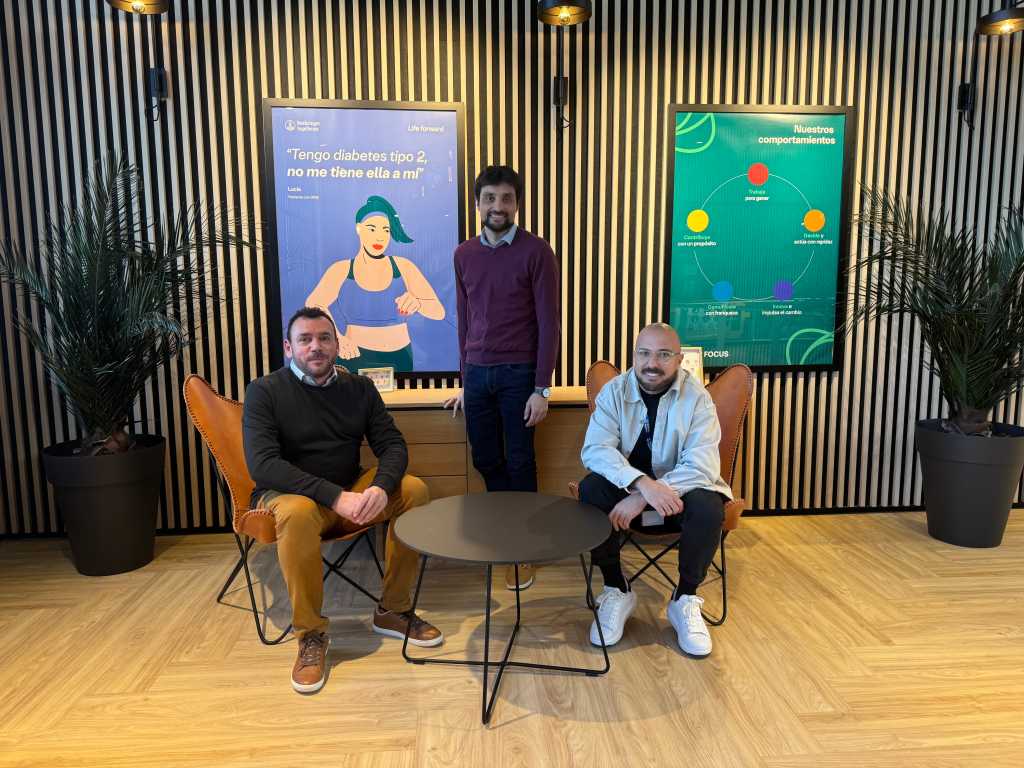Founded in 1885, the multinational pharmaceutical company has been more recently immersed in an ongoing transformation process based on the notion that behind every piece of data, there’s a person whose life can change for the better.

Lluís Roy i Català, Albert Borràs Rosell, and Marcos Buria Sanz.
In short, family-owned German multinational pharma giant Boehringer Ingelheim’s purpose is to improve the health and quality of life of patients through constant innovation, and the strategic use of technology. By virtue of this pursuit, combined with an ambitious approach to transformation, real value for people is achieved.
“Innovation and new technologies are key areas we pay a lot of attention to,” says Albert Borràs Rosell, global coordinator of data modeling services at Boehringer Ingelheim’s Human Pharma division. “It’s vital to study them to better understand their potential and added value to those that already exist, rather than rushing into current opinion. The technologies and digitalization already adopted position us to take full advantage of various business processes.”
One of the company’s main objectives has been to democratize data access to ensure the entire organization can optimize processes, accelerate research, and significantly reduce times in clinical trials. This not only allows them to be more efficient, but brings innovative solutions to market faster to benefit patients.
To achieve this, the company has migrated its technological solutions to cloud environments where data is collected in real time using IoT devices and other asynchronous sources, says Rosell. “We can build a single source of truth that’s accessible under strict governance and access control protocols, always ensuring privacy and security,” he says.
A fundamental sense of security
A key pillar in Boehringer’s transformation has been its commitment to cybersecurity. “We’ve strengthened our capabilities to protect not only our networks and equipment, but our data, which is our most valuable asset,” says Lluís Roy i Català, the company’s IT functional architect. “The trust of our employees, partners, and patients depend on our ability to safeguard this information in a comprehensive way.”
Plus, there’s been significant progress implementing several automations, so potential threats can be quickly identified and responded to, ensuring protection of systems and data.
These advanced automation solutions have also been key to progress and communication. “We’ve strengthened preventative actions through intelligent log analysis, which helps us anticipate potential vulnerabilities before they materialize,” says Català. “This automation helps our internal operations and improves the experience of our employees.”
So thanks to these strategic investments, the company is best positioned to analyze data with accuracy and quality. “We use advanced AI-powered analytics methods, from both a business and information technology perspective, to derive previously unattainable interpretations and predictions,” he adds. “These not only help us make more informed decisions, but anticipate future trends and needs.”
And thanks to early and well-planned investments, the company is in a solid position to optimize costs without compromising standards or impacting initiatives. “This demonstrates our ability to manage resources efficiently, and our long-term vision to ensure investments generate tangible value for our employees, partners, and patients,” says Català. “Every step in innovation and technology is designed with the patient in mind because we know that behind the data are people whose lives we can transform.”
Of course, regarding AI, the company is actively evaluating user behavior analytics technology, which detects anomalies that could indicate security threats. “This is a step forward in the proactive prevention of incidents,” he says.
And the company has implemented its own language model to analyze malicious emails reported by its users. “This tool allows us to filter and respond more effectively to phishing attempts and other social engineering tactics, which protects our organization from potential security breaches,” says Català. “We continue to explore and adopt new technologies to stay ahead of the curve in an ever-evolving business and technology environment.”
Gaining a wider perspective
While technology is important, what ends up making the difference is its use and application by the people within the organization. “We look for flexible and scalable technologies that can provide elasticity depending on the use case,” says Rosell. “In general, those with good foundations in data processing, a holistic vision and with ease of integration with other market standards can make a difference in the future. And all this without forgetting that scalability, rapid adoption and factorization are key elements for any global company.”
Marcos Buria Sanz, head of the global services team for data enablement within the Human Pharma division, stresses that the multinational’s data strategy is focused on transformation and standardization. “Both are critical to business direction, and launch visibility in the coming years,” he says.
Virtues of trusted partners
Through standardization and digital transformation, Sanz says, Boehringer aspires to strengthen and streamline data consumption at a global level, providing a clear and consistent vision in each market that allows decisions to be made in an agile way, thus impacting the launch of new products and directing the business in the timeliest manner.
Specifically, the company has adopted Snowflake to modernize its data and analytics infrastructure. “We carried out an exhaustive analysis of the requirements both from a technological and usability point of view, with the aim of identifying the solution that best aligned with the needs of our business,” says Català. “After evaluating various alternatives, we selected Snowflake as our corporate data platform for our data warehousing needs.”
This technology makes it easier to obtain maximum value from the data and solves the problems of previous generations, adds Sanz. “The strategy includes an actionable data governance model, which helps ensure data quality and consistency for different use cases globally,” he says.
Rosell adds Boehringer has always understood that data management is essential for knowledge, optimization of resources, and decision-making. And with cloud computing and adopting Snowflake, the organization has detected a tremendous opportunity to advance its ambition to eliminate redundancies, dispersion, and silos of data, and to promote higher levels of synergies and more transparent governance.
In addition, Snowflake has a solid track record working with companies in pharma, which guarantees its ability to adapt to Boehringer’s specific needs, and allows teams to focus on generating value without complex technical distractions. A key feature, Català adds, is its ability to decouple from a specific cloud provider, granting them strategic freedom and no future dependencies. “Its SaaS model resulted in a significant reduction in costs associated with maintenance and administration, freeing up resources to invest in innovation,” he says.
This choice strengthens its current technological infrastructure and lays foundations for sustainable and agile growth.
Lessons learned and transforming for the future
Initially, Borràs and his team were surprised by the ease with which Snowflake allowed them to migrate and improve previous on-prem solutions, its ability to process large volumes of data with an adjusted computation cost, and how developers adopted it. Later, they found it not only offers data storage and processing, but stands as a holistic platform that streamlines application development based on AI with services such as Cortex, Document AI, or Streamlit.
Transitions were much smoother than expected, too, says Borràs, and it always helps to surround yourself with professionals who know the tech in advance. So added support from specialized data partner SDG Group was helpful to accelerate and develop the first pilot with Snowflake, as well as in the subsequent process of the tech’s maturity.










